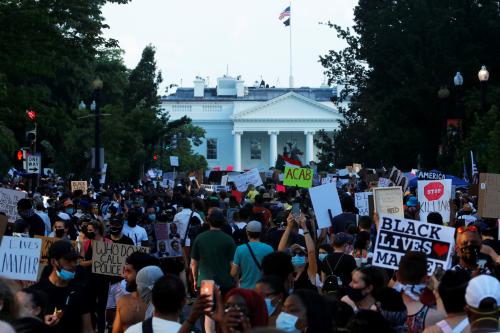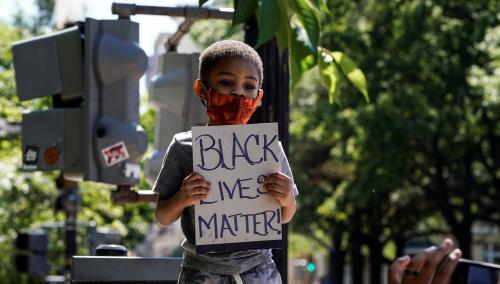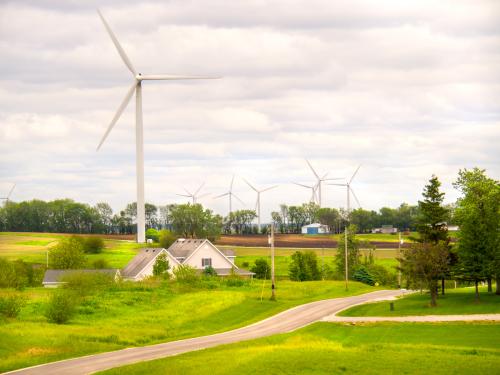In a raucous first presidential debate, there were few coherent moments. Among Donald Trump’s many distractions and personal attacks, he turned a question about homicide rates to the suburbs. “Our suburbs would be gone” under a Biden presidency, he claimed. “You would see problems like you’ve never seen before.”
Over the last several months, the topic of suburbia has been of endless fascination to the President. He has made inflammatory comments in press briefings, late night tweets, policy statements, and a recent op-ed in the Wall Street Journal penned with U.S. Department of Housing and Urban Development Secretary (HUD), Ben Carson. While presumably related to HUD’s recent decision to revoke the Obama-era Affirmatively Furthering Fair Housing (AFFH) regulations, Trump’s comments have often extended far beyond the narrow ruling, leading many to question his obsession with suburbia. The op-ed offers his clearest statement as to why.
America is often perceived as being deeply divided between rural Republican and urban Democratic strongholds. Suburbia, it is often said (though less often proven) is the land of swing voters—the place that decides elections. That appeared to be the case in 2016, when Trump won the suburban vote and the White House by narrow margins. Since then, suburban voters seem to be slipping from his narrow grasp—and Trump is more determined than ever to win them back, largely by appealing to suburban stereotypes and racial tropes.
Urban policy makers are convenient scapegoats for what conservatives cast as failed liberal policies. Trump and Carson attack the two African American senators leading efforts to enforce 50-year old fair housing laws, implying that suburbanization (implicitly of Black and Brown Americans) is a response to “failed liberal governance” of cities they represent that are “unaffordable” and “unlivable”.
Playing on longstanding fears of cities as crucibles of crime, disease, and dysfunction, Trump and Carson recast urban history as a series of failed policies that spread from cities to suburbs, rather than from the federal government to local municipalities. They ignore decades of population growth and capital investment in Democrat- and Republican-led cities. They forget bi-partisan neoliberal urban policies, including HUD’s opportunity zones that led to a pre-pandemic affordable housing crisis and widespread urban displacement.
Trump and Carson elide the federal government’s abysmal response to the pandemic that devolved responsibility to states and municipalities lacking adequate public health resources and guidance, and the cascading economic crises that followed. They dismiss the relative success of Democratic mayors in securing lives and livelihoods with insufficient federal support for small businesses, homeowners, renters, and low-wage workers compared to Republicans who followed Trump’s lead and rushed to “open their economies”.
Instead, Trump tries to assuage white guilt, particularly that of suburban women which he calls “housewives”, justifying their defense of their “suburban lifestyle dreams”, even if from the specter of the racialized “other”. Some have shirked his openly racist, misogynistic comments. The latest statement softens Trump’s typical hard-edged racism, acknowledging that most people of color also live in suburbs. This is not an appeal to Black and Brown voters. It is an assurance to white suburbanites that the “shameful days of redlining are gone” and their desire for homes “in safe, pleasant neighborhoods” are what all Americans want.
Trump’s anti-density, anti-change message offers false comfort to “color blind” liberals that supporting exclusionary housing policies that reinforce the racist status quo is not racist. It denies how racism has shape shifted from de jure to de facto practices that uphold white supremacy—through tax policy, historic preservation and design guidelines, private lending, home assessments, municipal incorporation, and zoning.
Trump and Carson want white Americans to invest in an ever-elusive suburban dream. “[S]uburbs are a shining example of the American Dream,” they write, “The left wants to take that American dream away from you.”
The postwar period of racially exclusive, tight-knit suburbs that gave birth to the middle-class mark the height of American “greatness” to many white Americans. Decades of deindustrialization, a declining welfare state, corporate deregulation, and global capitalism have torn away at that dream. Their sense of security has withered alongside once-shining suburbs—mirroring larger economic inequality trends. Many have watched poverty, foreclosure, and unemployment rates rise in their communities, while other suburbs became increasingly exclusive and advantaged.
The pandemic and economic crises threaten to strip away the pretense of American exceptionalism and myth of meritocracy. Trump and Carson do not want white America to see itself as recipients of federal welfare policies that made suburbs possible, profitable, and desirable–from Federal Housing Administration loans and interstate highways to mortgage interest deductions. Instead, they position white suburbanites as defenders of democracy in their commitment to private property rights and local control–Americans who “voted with their feet” and grew their communities “from the bottom up.”
Trump and Carson reinvest in a suburban success story they hope will keep white suburbanites from supporting policies that might benefit them for fear that others might reap unearned advantages. They want suburbanites to equate American-ness with securing their homes—not from predatory real estate companies like that of Trump’s son-in-law and senior White House adviser, Jared Kushner, already profiting from their pain that he helped to create. Not from landlords like Trump, who has been sued by the federal government for denying housing to African Americans in violation of the Fair Housing Act. And not from “tyranny” of the occupant of the most powerful seat in the nation—but from that of big government boogeymen like Joe Biden and Bernie Sanders plotting to build low-income housing in their back yard.
It is not clear whether Trump’s suburban strategy is a winning one. According to some polls, the suburban winds are gathering behind Biden’s sails. In others, Trump still holds the lead. And while Trump has taken his appeal directly to swing suburbs, Biden’s counter strategy is less clear.
For longtime advocates of equitable development, the politics are disturbing, but have brought attention to policies that have been opening up housing for low-income households in suburbs and other “high- opportunity neighborhoods” for decades. Fortunately, many of them do not require the blessing of the federal government, as land use policy is largely set at the local level.
Recent reforms enacted in localities, regions, and states across the U.S. offer promising possibilities with either a recalcitrant or hostile future federal administration.
- Minneapolis and Oregon have all but banned single-family zoning, allowing for denser, and presumably more affordable, housing in low-density neighborhoods. In Portland, state-level reforms allowed the city to revamp its zoning code to allow duplexes, triplexes, fourplexes, and accessory dwelling units in neighborhoods previously zoned for single-family homes. Many other states and municipalities are considering similar bans.
- Several states, including Washington, incentivize private developers to build low-income housing in “high-opportunity” suburban neighborhoods by assigning them additional points in their housing tax credit allocation system. In Seattle’s King County, the housing authority also works with Housing Choice voucher holders to help them locate housing opportunities in “high-opportunity” neighborhoods by providing tenants with educational, housing search and financial assistance to move into these areas.
- Baltimore put in place a similar program to Seattle’s as part of a settlement of federal lawsuits filed by public housing tenants over racial discrimination in the citing of subsidized housing. The region has since set aside vouchers for families to move into high-opportunity neighborhoods and established a regional project-based voucher program to build new low-income units in these neighborhoods. The state of Maryland also recently passed a statewide law preventing landlords from denying housing to voucher holders after Baltimore suburbs and many others throughout the state consistently refused to do so.
These places are not only testbeds for effective policy making. They show the kinds of political organizing and capacity building needed to make progress regardless of who the next occupant of the White House is.






Commentary
Why is Trump obsessed with suburbia?
October 5, 2020